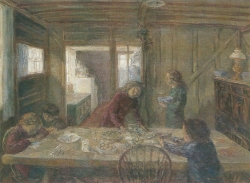|
Anyone who has taken a serious interest in the visual arts during the past 15 years will be aware that a significant change in general attitude has taken place. Fifteen years ago, peculiarly mindless forms of modernism exercised almost effortless dominion. At that time, constructors of conceptual inanities discussed the hoped-for death of painting with a relish made keener by the knowledge that they would never have to compete again as craftsmen with artists who worked harder or were better equipped. Art without rules habitually favours the untalented and unintelligent. In 1974 I saw my first painting by John Wonnacott and commented on it favourably to the artist. John Wonnacott formed with John Lessore, who is exhibiting currently at Nigel Greenwood (4 Burlington Street, W1), a teaching partnership at Norwich Art School known by colleagues everywhere as ‘the two Johns’. For ten years their passionate commitment to the traditions of drawing made the East Anglian life room they ran an object of awe and envy. Possibly it was the latter sentiment which caused their project to be shut down summarily some four years ago, an idiocy yet to be explained satisfactorily. Former students of the pair still tell me of how indebted they feel to the enthusiasm of their past mentors. The ‘two Johns’ studied at the Slade and form, with another ex-Slade student, Leonard McComb, three of the more accomplished talents in British art which have become overdue now for wider international recognition. Lessore’s art is the least obvious of the three, employing very limited tonal range and colour to create a personal poetry. The mind turns to Van Gogh before he went to Paris. By contrast, Lessore’s ‘Potato Eaters’ manage to eat beef. His series of paintings of his family either at, or about to go to table, gain in gentleness by their apparent artlessness. The figures in ‘Sunday II’, a modest-sized painting with disproportionate impact, transported me back to the world drawn so reassuringly by the late Edward Ardizzone; it is a world where a bee in the jam is just about the worst that could happen. Lessore’s colour seems dour and north European, yet oddly the domestic contentment he paints recalls the spirit of Renoir and other luminous Impressionists. A similar composition is called ‘Two Boys and a Woman at a Coffer‘. Here the title and location transport us back to the 18th century or earlier. The cottage wall the artist depicts is constructed of mud and. straw within a diagonal ash-wood framework. Lessore paints not so much with passion as compassion. His vision is kinder by far than that encountered in the general run of expressionist art. Indeed, his art has links with expressionism only because the struggle involved in making it is left on the surface and is considered part of the work’s essential integrity. Lessore’s forms are observed but far from crisp. One is tempted to doubt their scale and proportion simply through their roughness, yet closer inspection often shows the extent to which the artist’s forms are seen as well as felt. I prefer the domestic interiors he paints to those of outdoor light, where his control becomes less consistent. ‘The Letter, Evening II’ is of an affecting moment: the artist’s wife engrossed in writing a letter at a garden table on the sort of sunlit English day we seldom seemed to experience much until last year. Bright yellows appear here, but the complete exclusion of this third of the primary spectrum from the palette used for a series of interiors featuring artist and model gives the latter a ghostly silveriness. This may recall Watteau for some but there is an odd claustrophobia also, reminiscent of the interiors of James Pryde. I have known the paintings of Catherine Goodman, showing now at Cadogan Contemporary (108 Draycott Avenue, SW3), since she was a student at the Royal Academy Schools, a home of sound artistic sense and practice - by tradition, at least. She was taught there by John Lessore among others, and has built promisingly since then on a distinctive vision and talent. Her paintings are soft in form and often sumptuous in colour, and feature subject matter unusual in our present irreligious time. Among a dozen large paintings, ‘Lough Bawn’, ‘Entombment’ and (Saint) ‘Sebastian’ stand out. The last bears an odd resemblance to Ted Dexter sporting a towel after showering, barbed, perhaps, by the misfortunes of England’s cricket team. Herein lies one of the difficulties of re-enacting traditional Christian subject matter when using contemporary models. A further 50 drawings, paintings and watercolours make up a large-scale show of unusual and heartening quality from an artist still in her twenties. Unlike so many students of her era, she was lucky in her teachers. © Giles Auty and The Spectator |
